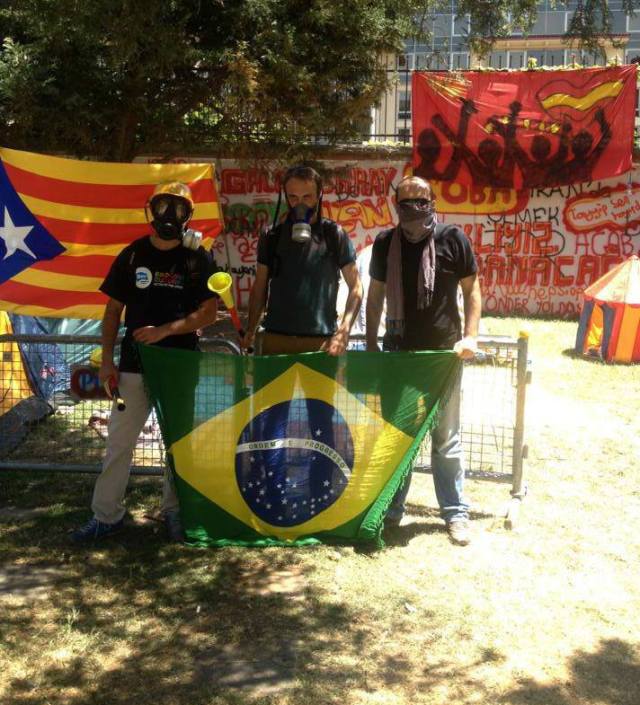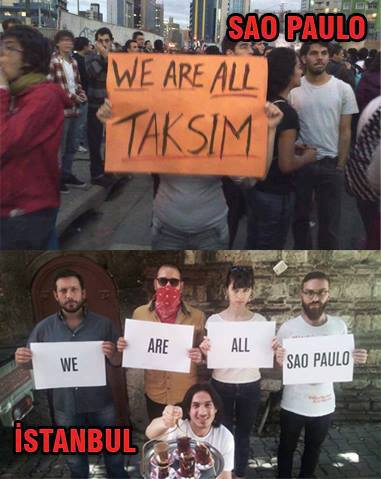The long march for freedom and justice in Turkey and Brazil
My facebook is blowing up. Having lived in Brazil as well as Turkey, my friends in both countries are filling my newsfeed with images and snapshot reports of the mass protests in Istanbul, Rio and other cities. Here is what I’ve learned (not just on Facebook) from comparing the situation in the two countries:
The protests in Turkey and Brazil have many things in common.
Both countries have been widely seen as successful emerging economies for the last decade (they form part of the BRICS and CIVETS groups, respectively). They both have overcome hyperinflation and currency crises, have enjoyed fairly rapid economic growth, have reduced poverty and expanded their middle classes. Even in the lens of the “inclusive growth” zeitgeist, Turkey and Brazil did fairly well as unemployment fell and human development indicators improved
One could make a case that both countries are more free, democratic and safe than ever before in their histories, even though significant limitations on freedom and human rights remain (especially in Turkey). Recent news such as the pacification of Rio’s favelas and the prospects of a peace agreement with Kurdish separatists in eastern Turkey only added to the optimism.
But in both countries the protests were ignited by a seemingly small spark: a small park in central Istanbul here, a 10-cent rise in bus prices there. Yet they would spread quickly, and in less than a few days the movements would be about much greater, much more fundamental issues.
In both cases, a disproportionate reaction by the police, including physical violence and the tear gassing of peaceful protesters, played a crucial role in escalating the protests. At the same time, the spread of those images via social media (along with suspiciously poor coverage in mainstream outlets) allowed protesters to gain widespread support.
Not unlike the uprisings of the Arab Spring, social media has been key in organizing, documenting and promoting the movements in Turkey and Brazil.
Most interestingly, the protesters themselves seem to be a very similar kind of people in both countries. They are mostly young, middle-class, well-educated student types who find wide support among the older bohemian-intellectual class as well as disillusioned ordinary citizens (more on the middle class origins of the Brazilian protest here).
There is even some indication that the protests in Turkey and their celebration in social media inspired many young Brazilians to take to the streets and displays of solidarity between the two movements abound.
Yet there are also significant differences.
Notably, there has been much more violence and bloodshed in Turkey, with at least four dead, and hundreds wounded and arrested. One might attribute this to different mentalities (if you’ve ever seen soccer fans in Turkey and Brazil you get the point). But while I have not seen any clear evidence that the protesters in Turkey are more violent than those in Brazil (there were some acts of violence and vandalism in both places), the police reaction has been much more brutal in Turkey, leading to the high number of casualties.
Hence, the most important difference to me lies in the relationship between the protesters and the government and the government’s reaction to the protests.
While the protests in Turkey built on a deep and long standing antagonism between the governing islamic-conservative AK Party of Prime Minister Erdogan and the secular urban middle-class which regularly votes for the opposition, the Brazilian protest movement is not easily defined in terms of politics. The core of the movement around the tarifa zero activists, who demand free public transportation, should probably be seen as to the left of the center-left government of President Dilma Rousseff.
The mostly wealthy supporters of the center-right opposition appear to be most likely to dismiss the protesters as vagabundos – useless troublemakers more interested in vandalism and looting than working for a living. Yet the lines are clearly blurred as my facebook shows hardcore leftist and libertarian friends alike supporting the protests.
While in Turkey escalation and crackdown has trumped any notion of compromise, the Brazilian government’s reaction, while initially fierce , has become increasingly conciliatory. Given the federal nature of Brazil, with the police and many other government functions being run by state and local officials, a single polarizing figure like Erdogan does not exist in Brazil. President Dilma differentiates clearly between those committing vandalism (“unacceptable”) and the majority of peaceful protesters (“they need to be heard”).
Hard to imagine Erdogan making such a statement. Not surprisingly, protesters in Turkey have demanded Erdogan’s resignation, while their Brazilian peers show plenty of dissatisfaction for politicians in general but no particular antagonism to an individual leader or party.
A common cause
Ultimately, I believe, the reason why the people are in the streets in Turkey and Brazil comes down to the same basic idea: the people have become fed up with public officials and the status quo.
They have come to expect more from their governments.
Providing macroeconomic stability, income growth, shopping malls and sporting events is not enough anymore for the people of Brazil, Turkey and other emerging countries (remember Chile 2011?). Call them spoiled, but the new generation, which has come of age after the turbulent times for the 1990s and early 2000s, increasingly demands more and other things from their government.
They want quality public services – education, health, infrastructure, public spaces. They want a government that listens and is attentive to their preferences about how to develop the country, how to design the cities and how to prepare for big sporting events. But most of all they demand individual liberty, respect and accountability.
Whether it is restrictions on basic liberties like freedom of speech or consumption of alcohol (Turkey), government waste and embezzlement of public funds (Brazil) or widespread impunity for crony politicians and brutal police forces (both), the new generation will not put up with it even if a government can rightly claim to be advancing the countries development and global standing.
Follow No Se Mancha on Facebook




Interesting article. Another link between the two protests: the tear gas. The tear gas used in both countries was Made in Brazil. Brazil is the second largest exporter of tear gas to Turkey after the United States.
Hello Cornelius, how are you?
It is an interesting analysis you provide here. There are indeed many elements in common between both events and the mutual support people are showing in Brazil and Turkey adds to that perception.
But, when noting the differences, it is also important to stress that exactly because of Erdogan’s centrality in Turkish politics people became united to protest against his conservative policies. The construction of the mall in Taksim, being just one of them. Some could say he is slowly turning Turkey a more religious country, bit by bit. You can see, for example, that protests are stronger in cities where AKP has little support.
In Brazil, what we have seen in the streets is that people are coming to the protests for many, many different reasons. I would say that there are groups advocating for diametrically opposite causes in the same event. One girl in the street, when asked why she was there protesting, she responded “I actually don’t see a reason why not to protest”. That’s one reason why we have generalised protests, regardless of the political party of the protesters (with even some people advocating for a movement without political parties).
This “fragile” unity in the case of Brazil and the marked opposition to a political programme in Turkey is a central difference that will probably mark diverse paths for the protests in both countries. What are those paths we are yet to see.
By the way, the way I see it, the “pacification” of Rio’s favelas was one of the reasons why people have come to the streets in first place. While there is some positive aspects of it, the occupation was done with much violence, also against common citizens, and the whole program lacks the elements that would turn the temporary “pacification” to a real social inclusion of these neighbourhoods. What the government should really do is to provide basic services to improve the conditions of the people living there (improving sanitary and transportation conditions, building schools, hospitals and other public services) and work to avoid people turning to criminality for lack of other opportunities.
Well, I guess what we have to do is to engage in this political debate and hope for political changes all around! See you at the streets!
Pingback: Latin America News Flash | No Se Mancha
“Protesters in Turkey have demanded Erdogan’s resignation, while their Brazilian peers show plenty of dissatisfaction for politicians in general but no particular antagonism to an individual leader or party.”
What about Feliciano?
Your right that Marco Feliciano is a polarizing figure and many protesters want to see him gone. But then the protests against him started back in March and were much smaller. The protests now are fueled by many issues (bus fares initially, spending on the World Cup, lack of quality public education and health care). Feliciano and social issues in general are in there too, but not really dominating after all he doesn’t quite have the power and standing of an Erdogan.
(anti Feliciano protests back in March: http://riotimesonline.com/brazil-news/rio-politics/protests-continue-over-feliciano-election/#)
Pingback: No Se Mancha Co-Founder on NPR | No Se Mancha
Super interesting comparison! thanks for posting this, I really didn’t know much about either situation.
Pingback: The Roar of a Nation | No Se Mancha
Pingback: The End of an Era: Why the commodity super cycle is probably over… | No Se Mancha
Pingback: Eike Batista: The Symptom or the Cause? | No Se Mancha
Pingback: Eike Strikes Out | Avenida América
Pingback: Football in Latin America | No Se Mancha
Pingback: GED Blog | Three Things to Watch in Brazil - GED Blog